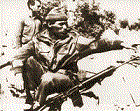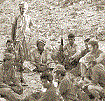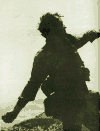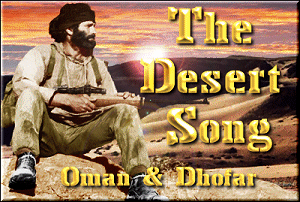Operation Jaguar

Operation Jaguar began in October 1971 with G Squadron SAS, a battalion of the Sultan's Armed Forces and 5 Firqats, all under the command of Lieutenant Colonel Johnny Watts MC (Royal Irish Rangers). The purpose of Jaguar was to get back control of the djeble (mountains) and establish a permanent base there. At this time the British Government only allowed one SAS squadron to operate in Dhofar at a time. However, because of the size of the operation Watts was allowed to bring in B Squadron SAS as well to act as reserve force. B Squadron was commanded by Richard "Duke" Pirie. This move by Watts proved to be very crucial. By the time the operation began, only 40 members of G Squadron were fit enough to go into the field due to many troopers being laid low after contracting hepatitis from contaminated water. The OC of G Squadron was one of these men. Temporary command of G Squadron was handed over to Shaun Brogan. The picture on the left shows Johnny Watts. Standing behind him is a young Peter de la Billiere. In 1990 General Sir Peter de la Billiere commanded British forces during the Gulf War. This picture (Left)was taken in January 1959 when Watts commanded D Squadron SAS during the Jebel Akhdar campaign.

The plan called for the main force to enter the mountains from the north while a smaller diversion force attacked the Adoo in the east. The smaller force commanded by Brogan soon came under long range sniper fire from the Adoo as they advanced up the djeble. The Adoo were firing at such a long range that their bullets were spent before they arrived at their selected target. As Brogan led his men farther into the djeble the attacks grew more frequent. On the third night of the advance, the SAS had their first major contact of the operation as they moved towards a group of low hills. The SAS came under fire from the hills and attacked. Brogan and his men easily took the hills and set up defensive positions. The next morning they came under intense enemy fire and Sergeant Steve Moores was badly wounded in the stomach. The attack was beaten back by the SAS and Firqats using mortars. Sgt. Moores was casevaced by helicopter to RAF Salalah where he was operated on. Sadly he died on the plane while being flown back to Britain for further treatment.
The two SAS forces joined up soon after and established a strong hold on the djeble. Before Operation Jaguar, the Sultan's troops had tried many times to drive the Adoo off the djeble. Each time the Adoo had found that if they fought hard for the first few days that the government forces would crumble and leave the djeble. This time would be different.

The SAS established themselves on a hill they called "Porkchop Hill". The Adoo attacked in strength thinking that they would drive the infidels off within a few days. The battle raged for 4 days with over 40 attacks taking place. The SAS came under more enemy fire than any British soldiers since the Korean War. The Adoo were armed with AK 47s, SKS semi-automatic rifles, 7.62 light MGs, 12.7 heavy machineguns and mortars. All this firepower was poured into the SAS positions. The SAS gave just as good as they got with mortar and machinegun fire but it was a close run thing. At one point a group of Adoo managed to get so close to Sgt. Mick Seal's position that he had to lift the back legs off the tripod of his machinegun to get it to fire on the Adoo below.

Watts, having established his small hold on the one part of the djeble, started to spread his force out and build strong points all over the djeble. It was hoped that these strong points would deny the Adoo from bringing weapons and supplies in from Yemen. Watts named this line of positions the Leopard Line. The SAS built smaller defensive positions called sangars, which were small stone bunkers; a trick the regiment had learnt during their time on the Jebel Akhbar in 1958. From these strongholds, Watts sent out patrols to make contact with the Adoo. Watts led from the front and sometimes both he and his two squadron commanders would lead patrols. All the SAS officers and men worked very closely with their Firqats bringing both groups together with an excellent feeling of cameraderie. The Firqats fought hard but were some times a little hard to work with. One day they would be fighting the Adoo, the next they would decide to take the day off. If this happened during a major contact with the Adoo, Watts would be forced to commit B Squadron to the fight as his main force.

The battle for the djeble turned into a slogging match with both sides duelling for control. Both SAS Squadrons were starting to get worn down with the long periods of fighting but the Adoo were taking many more casualties. They no longer engaged the SAS at close quarters but preferred to take pot shots at long range. B Squadron had taken many casualties during the operation and the strain was starting to show. At one point Duke Pirie, commander of B Squadron, refused to send his men into battle when ordered to by Watts. This was in no way an act of cowardness by Pirie, he was just fed up losing his men. He only agreed to take his Squadron into action after Watts threatened to fire him on the spot. B Squadron went into battle and fought a hard action with the Adoo. More SAS men were killed in this action but it broke the back of the Adoo's hold on the djeble.
By the summer of 1972 just about all the Adoo had been driven off the djeble. The SAS now consolidated their hold on the mountains and carried out another type of warfare. This time it was a hearts and minds operation. A permanent base was established called "White City" and later the name was changed to Medinat Al Haq, the place of hope.



